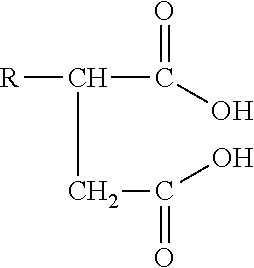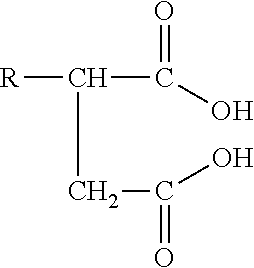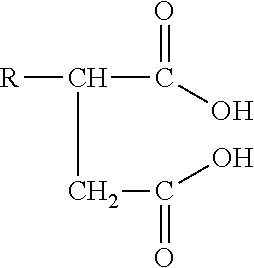Fuel additives for treating internal deposits of fuel injectors
- Summary
- Abstract
- Description
- Claims
- Application Information
AI Technical Summary
Benefits of technology
Problems solved by technology
Method used
Image
Examples
##ventive example 12
Inventive Example 12
[0040]950 MW polyisobutenylsuccinic diacid.
##ventive example 13
Inventive Example 13
[0041]Mixture of C20-C24 alkenyl succinic diacid.
##ventive example 14
Inventive Example 14
[0042]450 MW polyisobutenylsuccinic diacid
TABLE 2Power ChangePower ChangePowerInjectorAdditive TreatAfter Baseafter AdditizedRecovery afterSticking AfterRunAdditive Used forRate (activeFuel Dirty UpFuel Clean UpAdditized FuelAdditized FuelNo.Clean Upppm by mass)(%)(%)Clean Up (%)Clean Up1Comp. Ex. 2500−4.48−4.441Yes2Comp. Ex. 7500−4.87−4.606Yes3Comp. Ex. 7500−4.60−4.0612Yes4Comp. Ex. 8500−4.04−4.62−14Yes5Comp. Ex. 9500−4.62−6.63−44Yes6Inv. Ex. 12500−2.950.88130No7Inv. Ex. 12300−4.06−1.5462No8Inv. Ex. 12300−7.92−5.0536No9Inv. Ex. 13300−3.26−2.5023No
[0043]As shown in Table 2, the hydrocarbyl-substituted dicarboxylic acid additive (Run 6) was significantly more effective for improving power recovery than the conventional additives of Runs 1-5 at a treat rate of 500 ppmw. Even at a lower treat rate of 300 ppmw, the hydrocarbyl-substituted dicarboxylic acid additive (Runs 7-8) was significantly more effective for power recovery than the conventional additives at a tre...
PUM
 Login to View More
Login to View More Abstract
Description
Claims
Application Information
 Login to View More
Login to View More - R&D
- Intellectual Property
- Life Sciences
- Materials
- Tech Scout
- Unparalleled Data Quality
- Higher Quality Content
- 60% Fewer Hallucinations
Browse by: Latest US Patents, China's latest patents, Technical Efficacy Thesaurus, Application Domain, Technology Topic, Popular Technical Reports.
© 2025 PatSnap. All rights reserved.Legal|Privacy policy|Modern Slavery Act Transparency Statement|Sitemap|About US| Contact US: help@patsnap.com



